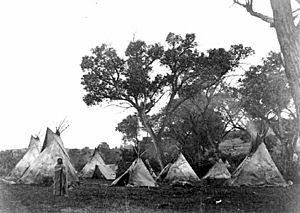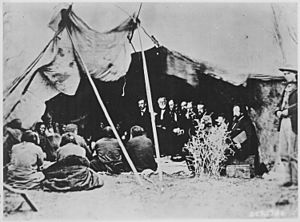Cheyenne and Arapaho Tribes facts for kids
| Total population | |
|---|---|
| 12,185 | |
| Regions with significant populations | |
| Oklahoma, United States | |
| Languages | |
| English, Arapaho language, Cheyenne language | |
| Religion | |
| Christianity, Native American Church, Sun Dance, traditional tribal religions | |
| Related ethnic groups | |
| Arapaho, Cheyenne, Gros Ventre, Blackfeet, and Suhtai |
The Cheyenne and Arapaho Tribes are a special group of Native American people. They are made up of two main tribes, the Southern Arapaho and Southern Cheyenne. They live in western Oklahoma and are officially recognized by the United States government.
Contents
History of the Cheyenne and Arapaho Tribes
The Cheyenne and Arapaho are two different tribes with their own unique pasts. They became strong allies over time.
The Cheyenne People
The Cheyenne (who call themselves Tsitsistas, meaning "The People") used to be farmers. They lived near the Great Lakes in what is now Minnesota. Their language is a special part of the Algonquian language family.
The Cheyenne Nation came from two related groups: the Tsitsistas and the Suh' Tai. The Suh' Tai joined the Tsitsistas in the early 1700s. These groups had important cultural heroes. Erect Horns, a Suh' Tai leader, received a sacred Buffalo Hat. Sweet Medicine, a Tsitsistas leader, was given sacred Arrows. These items became very important to their beliefs.
Inspired by Erect Horns' vision, the Cheyenne started using horses in the 1700s. They moved west onto the plains to follow the buffalo. The wise leader Sweet Medicine helped organize Cheyenne society. He set up the Council of Forty-four peace chiefs. He also created warrior societies led by brave warriors.
The Arapaho People
The Arapaho also spoke an Algonquian language. They came from areas like Saskatchewan, Montana, Wyoming, and Colorado in the 1700s. They also learned to use horses and became skilled nomadic hunters.
Around 1800, the Arapaho tribe started to form northern and southern groups. They helped the Cheyenne and Lakota push the Kiowa tribe south. But in 1840, the Arapaho made peace with the Kiowa. They became successful traders. However, American settlers began moving onto their lands after the Civil War.
A Strong Alliance
The Cheyenne and Arapaho tribes formed a strong alliance in the 1700s and 1800s. Together, they were a powerful military force. They were also successful hunters and traded actively with other tribes. At their strongest, their hunting lands stretched from Montana all the way to Texas.
Treaties and Land Changes
In 1851, the Arapaho signed the Fort Laramie Treaty with the U.S. government. This treaty recognized their rights to traditional lands in parts of Colorado, Kansas, Nebraska, and Wyoming. But the U.S. government could not stop settlers from moving onto these lands. This led to many conflicts between the tribes and the settlers.
In 1867, the U.S. government met with the tribes again. They signed the Medicine Lodge Treaty to try and make peace. The Arapaho were offered a reservation in Kansas, but they did not like the location. So, they accepted a reservation with the Cheyenne in Indian Territory. Both tribes were forced to move south near Fort Reno in what is now Oklahoma.
Later, the Dawes Act broke up the Cheyenne-Arapaho land. Land that was not given to individual Native Americans was opened up for settlers in the Land Run of 1892. The Curtis Act of 1898 tried to break up tribal governments. This was an effort to make tribal members live like other Americans.
Forming a United Government
After the Oklahoma Indian Welfare Act was passed in 1936, the Cheyenne and Arapaho tribes formed a single government in 1937. The Indian Self-Determination Act of 1975 helped the tribe develop even more.
Historic Southern Cheyenne Bands
The Southern Cheyenne had different groups, or bands. These bands often had unique names and histories. For example, the Heévâhetaneo'o were known as "Haire Rope Men" and were great warriors. The Hesé'omeétaneo'o were "Ridge People" who lived in hill country.
Some bands were caretakers of sacred items, like the Heviksnipahis, who cared for the Sacred Arrows. Other bands, like the Masikota, were mixed with Lakota people. Many bands were greatly affected by diseases like cholera or by conflicts like the Sand Creek Massacre.
The Cheyenne had a Council of Forty-Four chiefs. Ten main bands had the right to send four chiefs to this council. These included the Heviksnipahis, Heévâhetaneo'o, Masikota, and others.
After a cholera outbreak in 1849, some bands like the Masikota almost disappeared. The remaining Masikota joined the Dog Soldiers warrior society. The Dog Soldiers became a very important band. They often disagreed with the peace chiefs and played a big role in wars against the white settlers. Eventually, the Dog Soldiers separated and became a third main group of the Cheyenne people.
Economic Development
The Cheyenne and Arapaho Tribes run several businesses. They have three tribal smoke shops and five casinos. These casinos are called Lucky Star Casino and are located in Clinton, Concho, Watonga, Hammon, and Canton. The tribe also issues its own special vehicle tags. All these businesses help the tribe's economy, bringing in an estimated $32 million.
Institutions and Programs
The tribe has its own newspaper called The Cheyenne and Arapaho Tribal Tribune. They also have a low-power TV station, CATV channel 47 (K35MV-D).
The Cheyenne-Arapaho Tribes of Oklahoma Culture and Heritage Program teaches many important traditions. These include hand games, powwow dancing and songs, and how to care for horses. They also teach about buffalo management and the Cheyenne and Arapaho languages. The program has also sponsored running events.
College Education
The tribe partnered with Southwestern Oklahoma State University to create the Cheyenne and Arapaho Tribal College. It opened on August 25, 2006. The college offered programs in Tribal Administration, American Indian Studies, and General Studies.
In 2015, the college closed. However, in September 2019, the tribe found a new way to support higher education. They partnered with Bacone College in Muskogee, Oklahoma, making it their official tribal school.
Buffalo Program
The tribe has started a buffalo herd. This program helps them connect with their culture and provides food. In 2021, the herd grew to 530 bison. Denver Parks and Recreation donated 13 animals to help improve the herd's genetics. While "bison" is the correct scientific term, "buffalo" is commonly used.
Notable Tribal Members

Many talented people are members of the Cheyenne and Arapaho Tribes:
- Ross Anderson, a professional World Cup skier.
- William "Hawk" Birdshead, who started the Indigenous Life Movement.
- Archie Blackowl (1911–1992), a famous Flatstyle painter.
- Chris Eyre, a film director and producer known for movies like Smoke Signals.
- Suzan Shown Harjo, an activist, writer, and poet.
- Viola Hatch (1930–2019), an activist and former tribal chairperson.
- Lance Henson, a poet and painter.
- Yvonne Kauger, an Oklahoma Supreme Court Justice.
- Chief Little Raven (ca. 1810–1889), an Arapaho chief who signed the 1867 Medicine Lodge Treaty.
- Merlin Little Thunder, an artist known for his miniature paintings.
- Henrietta Mann (born 1934), an academic who developed Native American studies programs.
- Chief Niwot (1825–1864), a Southern Arapaho leader.
- St. David Pendleton Oakerhater (1847–1931), a veteran, artist, and a saint in the Episcopal Church.
- Tommy Orange (born 1982), a Southern Cheyenne novelist.
- Harvey Pratt, an artist, peace chief, and forensic artist.
- Henry Roman Nose (1856–1917), a Southern Cheyenne chief.
- W. Richard West Sr. (1912–1996), a Southern Cheyenne painter and educator.
- W. Richard West Jr., a Cheyenne lawyer and the first director of the National Museum of the American Indian.
- Wolf Robe (ca. 1840–1910).
- Gilbert Miles, a former lieutenant governor of the tribes.



